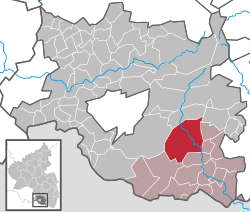Dahn
| Dahn | ||
|---|---|---|
|
||
| Coordinates: 49°9′N 7°47′E / 49.150°N 7.783°ECoordinates: 49°9′N 7°47′E / 49.150°N 7.783°E | ||
| Country | Germany | |
| State | Rhineland-Palatinate | |
| District | Südwestpfalz | |
| Municipal assoc. | Dahner Felsenland | |
| Government | ||
| • Mayor | Alexander Fuhr (SPD) | |
| Area | ||
| • Total | 40.75 km2 (15.73 sq mi) | |
| Elevation | 210 m (690 ft) | |
| Population (2015-12-31) | ||
| • Total | 4,595 | |
| • Density | 110/km2 (290/sq mi) | |
| Time zone | CET/CEST (UTC+1/+2) | |
| Postal codes | 66994 | |
| Dialling codes | 06391 | |
| Vehicle registration | PS | |
| Website | www.dahn.de | |
Dahn is a municipality in the Südwestpfalz district, in Rhineland-Palatinate, Germany. It is situated in the Palatinate Forest, approximately 15 km southeast of Pirmasens, and 25 km west of Landau. It is part of the Verbandsgemeinde ("collective municipality") of Dahner Felsenland.
Dahn is located 210 m above sea level in a valley of the Dahner Felsenland, a part of the Wasgau, which is itself a part of the Palatinate Forest. A small creek, the Lauter, flows through Dahn, and here, in the area of its headwaters, is called the Wieslauter. The border with Alsace (France) is located 10 km south of Dahn.
In 1952 the coat of arms was recreated as a result of historical research. The new shield, parted per chevron has on its dexter chief: azure (blue), a cross argent (silver); on its sinister chief: gules (red), an eagle argent (silver) and on its base: or (gold), a fir tree vert (green).
The fir tree (German: Tanne, [assumed to be linked to the name of the town]) was originally the only symbol of Dahn, however, the new coat of arms also commemorates the following historical points: The knights of Than, feudatories of the bishop of Speyer, were the lords of Dahn for over four hundred years and may have called themselves after the town. This was the reason for inferring the white eagle with red background from the knight's coat of arms which showed three white eagles (maybe the symbol for the three castles of Altdahn, Grafdahn and Tannstein). After the extinction of the House of Than in 1603, Dahn was the head office of a department of the diocese of Speyer. This situation lasted until the beginning of the French revolutionary wars in 1797/98. That is why the white cross was adopted from that diocese. The fir remains as a memorial to the name of the town, the old seal of the Court and the scenic location of the city in the Palatinate Forest.
...
Wikipedia



